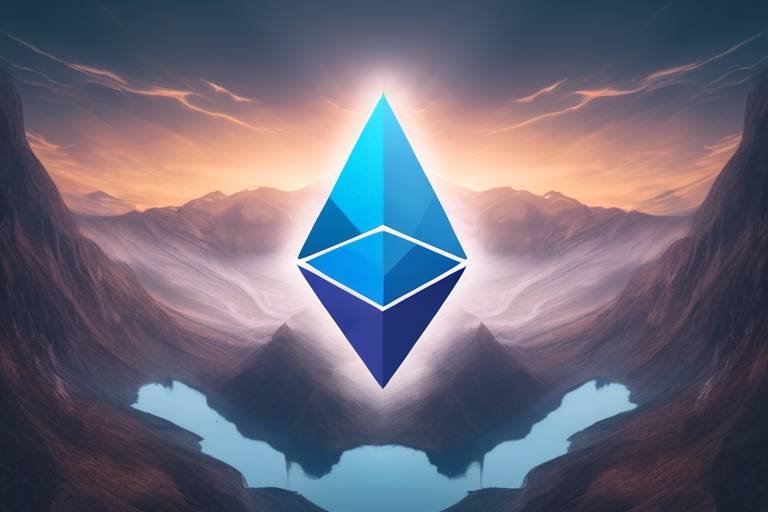Avalanche - The Future of Decentralized Finance
As the world of finance evolves, Avalanche emerges as a beacon of innovation in the realm of decentralized finance (DeFi). This cutting-edge platform is not just another player in the game; it’s a revolution that promises to reshape how we think about financial transactions. With its lightning-fast transaction speeds and low fees, Avalanche is capturing the attention of developers and users alike. Imagine a world where sending money is as easy as sending a text message—Avalanche is paving the way for that reality.
But what truly sets Avalanche apart? It’s not just about speed. The platform operates on a unique consensus mechanism that allows for a multitude of blockchains to coexist and interact seamlessly. This means that developers can create customized solutions tailored to their specific needs without being bogged down by the limitations of traditional financial systems. In an age where flexibility and adaptability are key, Avalanche is the answer to the demands of a rapidly changing financial landscape.
Furthermore, the potential impact of Avalanche on the financial ecosystem is monumental. By enabling decentralized applications (dApps) to flourish, Avalanche is creating a new financial paradigm where users have more control over their assets and transactions. This is a significant shift from the conventional banking system, where intermediaries often dictate terms and conditions. With Avalanche, the power is back in the hands of the users, and they can engage in a variety of financial activities without the constraints typically imposed by traditional finance.
In the coming sections, we will delve deeper into the architecture of Avalanche, explore its key features, and examine its real-world applications in the DeFi space. Buckle up, because the journey through Avalanche’s innovative landscape is just beginning, and it’s set to be a thrilling ride!
- What is Avalanche? - Avalanche is a decentralized platform that facilitates the creation and management of customizable blockchain networks.
- How does Avalanche ensure security? - Avalanche employs a robust consensus mechanism and various security protocols to safeguard user assets.
- Can I build my own decentralized application on Avalanche? - Absolutely! Avalanche allows developers to create their own dApps and subnetworks tailored to their needs.
- What are the benefits of using Avalanche for DeFi? - Avalanche offers low fees, high transaction speeds, and the ability to interact seamlessly with other blockchains, making it an attractive option for DeFi projects.

Understanding Avalanche's Architecture
Avalanche is not just another blockchain; it’s a revolutionary platform that redefines how decentralized finance (DeFi) operates. At its core, Avalanche utilizes a unique architecture that integrates multiple blockchains, allowing for unparalleled scalability and speed. This is achieved through its innovative consensus mechanism, which we’ll explore in detail shortly. Imagine a bustling city where every street is a different blockchain, all interconnected, yet each operating independently. That’s the essence of Avalanche's architecture!
One of the standout features of Avalanche is its ability to support a multitude of blockchains, often referred to as "subnets." These subnets can be customized to meet the specific needs of different applications or businesses, creating a tailored experience that is rare in the blockchain world. This flexibility not only enhances the user experience but also allows developers to innovate without the constraints typically found in other platforms. Think of it as having your own tailored suit that fits perfectly, rather than a one-size-fits-all approach.
The architecture of Avalanche is built on three core components:
- Platform Chain (P-Chain): This is the coordination layer that manages the network’s validators and facilitates the creation of subnets.
- Exchange Chain (X-Chain): This chain is responsible for asset transfers and utilizes the Avalanche consensus mechanism to ensure fast and secure transactions.
- Contract Chain (C-Chain): This chain is where all smart contracts are executed, allowing developers to build decentralized applications (dApps) efficiently.
By separating these functions into distinct chains, Avalanche can process transactions at lightning speed while maintaining high security. For instance, the P-Chain ensures that validators can operate independently, while the X-Chain focuses solely on asset transfers. This modular approach is akin to a well-oiled machine where each part has a specific role, resulting in seamless operation.
Moreover, Avalanche’s consensus mechanism, known as Avalanche consensus, is a game-changer. Unlike traditional proof-of-work or proof-of-stake systems, Avalanche consensus allows for rapid finality of transactions. This means that once a transaction is confirmed, it is considered final and irreversible almost instantly. In a world where time is money, this feature can significantly enhance the efficiency of financial transactions.
In summary, Avalanche's architecture is a sophisticated blend of flexibility, speed, and security. By supporting multiple blockchains and employing a unique consensus mechanism, it stands out in the crowded DeFi space. As we delve deeper into its key features and use cases, it becomes clear that Avalanche is not just a platform; it’s a vision for the future of finance.

Key Features of Avalanche
Avalanche is not just another player in the decentralized finance (DeFi) arena; it’s a game changer that brings a suite of powerful features to the table. Imagine a platform where speed meets security, and flexibility is at the forefront of its design. That's Avalanche for you! One of its standout features is low latency. This means that transactions are processed almost instantaneously, giving users a seamless experience. In a world where every second counts, especially in trading and finance, this is a massive advantage.
Another remarkable feature is its high throughput. Avalanche can handle thousands of transactions per second, which is a significant leap compared to many existing blockchains. This capability not only enhances user experience but also ensures that the network remains robust and efficient, even during peak times. Think of it as a busy highway that can accommodate a high volume of traffic without any bottlenecks.
Moreover, Avalanche allows for the creation of customizable blockchains. This means developers can tailor their own blockchain environments to meet specific needs, whether it’s for a unique application or for a particular industry. This level of customization opens the door for innovation, allowing businesses to create solutions that are perfectly aligned with their operational requirements. For instance, a gaming company could design a blockchain that optimizes for low transaction costs and high speed, while a financial institution might prioritize security and regulatory compliance.
One of the most exciting aspects of Avalanche is its subnetwork capabilities. Users can create their own subnetworks, which function independently while still being part of the larger Avalanche network. This feature is particularly beneficial for businesses looking to implement their own blockchain solutions without having to build everything from scratch. Subnetworks can be tailored to specific use cases, such as privacy-focused applications or those requiring unique governance models. The flexibility offered here is akin to having a custom-built home in a well-planned community, where you can design your space while still enjoying the amenities of the neighborhood.
But wait, there's more! Avalanche excels in interoperability as well. In the DeFi space, where multiple blockchains coexist, the ability to communicate seamlessly between them is crucial. Avalanche facilitates this interaction, allowing users to transfer assets and data across different networks effortlessly. This interoperability is like a universal translator in a multilingual conversation, ensuring that everyone can understand and interact without barriers. It enhances the user experience and broadens the scope of what’s possible in DeFi applications.
In summary, Avalanche’s key features—low latency, high throughput, customizable blockchains, subnetwork capabilities, and interoperability—position it as a frontrunner in the DeFi landscape. These characteristics not only enhance user experience but also empower developers and businesses to innovate and create solutions that meet the demands of a rapidly evolving financial ecosystem.
- What makes Avalanche different from other blockchains?
Avalanche's unique consensus mechanism allows for low latency and high throughput, making it one of the fastest and most scalable blockchains available. - Can I create my own blockchain on Avalanche?
Yes! Avalanche provides the tools to create customizable blockchains tailored to your specific needs. - How does Avalanche ensure security?
Avalanche employs robust security measures, including its consensus protocol, which enhances the safety of transactions and user assets. - Is Avalanche suitable for businesses?
Absolutely! The flexibility and customization options make it an excellent choice for businesses looking to leverage blockchain technology.

Consensus Mechanism Explained
At the heart of Avalanche's success lies its innovative consensus mechanism, aptly named the Avalanche consensus. This mechanism is a game changer in the world of decentralized finance (DeFi), as it enables transactions to be processed with astonishing speed and security. Unlike traditional blockchains that often rely on proof-of-work or proof-of-stake models, Avalanche employs a unique approach that leverages a combination of both, resulting in rapid finality and enhanced scalability. Imagine a bustling highway where cars can zip through without ever hitting a traffic jam—this is what Avalanche aims to achieve in the realm of blockchain transactions.
The Avalanche consensus mechanism operates through a process known as Snowball Sampling, which allows nodes to communicate and reach consensus quickly. When a transaction is initiated, a small subset of nodes is randomly selected to vote on its validity. This voting process is repeated multiple times, with each round reinforcing the likelihood of achieving consensus. The beauty of this system is that it can handle thousands of transactions per second, making it one of the fastest platforms available today. In fact, Avalanche can confirm transactions in less than a second, which is a significant leap forward compared to many existing blockchains.
To illustrate how this mechanism works, let’s break it down into a few key steps:
- Node Selection: A random sample of nodes is chosen to validate the transaction.
- Voting Process: The selected nodes cast their votes on whether the transaction is valid.
- Consensus Achievement: If a sufficient number of nodes agree, the transaction is confirmed.
This layered voting process not only increases speed but also enhances security. Each node independently verifies the transaction, making it extremely difficult for malicious actors to compromise the network. In other words, even if a few nodes were to act dishonestly, the majority would still uphold the integrity of the system. This decentralized approach ensures that Avalanche remains resilient against attacks, providing users with peace of mind as they engage in various DeFi activities.
Additionally, the Avalanche consensus mechanism supports the creation of customizable blockchains. Developers can build their own networks tailored to specific needs, all while benefiting from the underlying security and speed of the Avalanche platform. This flexibility is crucial for businesses looking to innovate and adapt in an ever-changing financial landscape. Think of it like a tailor-made suit—perfectly fitted to your specifications, offering both style and comfort.
In summary, the Avalanche consensus mechanism is not just a technical marvel; it represents a paradigm shift in how we think about blockchain technology. Its ability to facilitate rapid transactions while maintaining high security levels positions Avalanche as a frontrunner in the DeFi space. As we explore further into the capabilities of Avalanche, it becomes clear that this platform is not only paving the way for the future of finance but also redefining what is possible within the blockchain ecosystem.

Subnetwork Capabilities
Avalanche's architecture is not just a marvel of technology; it also offers incredible flexibility through its . Imagine being able to create your own customized blockchain, tailored to your specific needs, all while leveraging the robust infrastructure of Avalanche. This feature is a game-changer for developers and businesses alike, as it allows for the creation of highly specialized environments that can cater to various applications, from gaming to finance.
So, how does it work? Each subnetwork, or subnet, operates independently but is still connected to the main Avalanche network. This means that while you can create a unique set of rules, consensus mechanisms, and even token standards, you still benefit from the security and interoperability that Avalanche provides. For instance, a financial services company could set up a subnet with specific compliance rules that differ from the main network, ensuring that they meet regulatory standards while still engaging in decentralized finance (DeFi) activities.
The benefits of subnetworks extend beyond just customization. They also enhance scalability. By allowing different subnets to process transactions independently, Avalanche can handle a higher volume of activity without compromising speed or performance. This is particularly crucial in the DeFi space, where transaction speed can mean the difference between profit and loss. Businesses can also choose to limit access to their subnet, creating a private environment for sensitive operations, which adds a layer of security and control.
Moreover, subnetworks can facilitate collaboration among different projects. Imagine multiple decentralized applications (dApps) collaborating within their own subnet, sharing resources and data seamlessly. This creates a vibrant ecosystem where innovation can flourish, leading to more robust applications that benefit users across the board.
In summary, Avalanche's subnetwork capabilities are not just a technical feature; they represent a paradigm shift in how blockchain technology can be utilized. By allowing for customization, scalability, and collaboration, Avalanche empowers developers to push the boundaries of what is possible in the DeFi landscape.
Frequently Asked Questions
- What is a subnetwork in Avalanche? A subnetwork is a customizable blockchain that operates independently but is connected to the main Avalanche network, allowing for tailored solutions.
- How do subnetworks enhance scalability? By processing transactions independently, subnetworks can handle a higher volume of activity without slowing down the network.
- Can subnetworks have their own rules? Yes, each subnetwork can establish its own consensus mechanisms, token standards, and compliance rules.
- What are the benefits of using subnetworks for businesses? Businesses can create private environments for sensitive operations, enhance scalability, and foster collaboration among different projects.

Interoperability Features
In the rapidly evolving landscape of decentralized finance (DeFi), interoperability stands out as a critical feature that can make or break a platform. Avalanche excels in this domain, providing a robust framework that allows different blockchains to communicate and interact seamlessly. Imagine a bustling marketplace where various vendors set up their stalls, each offering unique products, yet all working together to create a cohesive shopping experience. That's what interoperability in blockchain is all about. With Avalanche, users can easily transfer assets and data across multiple blockchains, enhancing liquidity and user engagement.
One of the most exciting aspects of Avalanche's interoperability is its ability to support cross-chain transactions. This means that assets from one blockchain can be effortlessly moved to another, without the need for complicated processes or intermediaries. For instance, if you hold tokens on Ethereum, you can swap them for Avalanche tokens in a matter of seconds, thanks to the platform's sophisticated bridging technology. This not only saves time but also reduces transaction costs, which is a significant advantage for users looking to maximize their returns in the DeFi space.
Moreover, Avalanche's are not just limited to asset transfers. The platform supports smart contracts that can interact with other blockchains, allowing developers to create applications that leverage the strengths of multiple networks. This opens up a world of possibilities for innovation, as developers can build decentralized applications (dApps) that utilize resources from various ecosystems, creating a more interconnected and versatile DeFi landscape.
| Feature | Description |
|---|---|
| Cross-Chain Transactions | Seamless transfer of assets between different blockchains. |
| Smart Contract Interoperability | Ability for smart contracts to interact across multiple networks. |
| Bridging Technology | Facilitates quick asset swaps without intermediaries. |
This level of interoperability not only enhances user experience but also contributes to the overall health of the DeFi ecosystem. By allowing diverse blockchains to work together, Avalanche fosters a collaborative environment where innovation can thrive. As more projects recognize the importance of interoperability, Avalanche is poised to lead the charge, offering solutions that empower users and developers alike. In a world where every second counts and efficiency is key, Avalanche's interoperability features are a game changer, setting the stage for a more integrated and user-friendly financial future.
- What is interoperability in blockchain? Interoperability refers to the ability of different blockchain networks to communicate and interact with each other seamlessly.
- How does Avalanche achieve interoperability? Avalanche employs advanced bridging technology and supports smart contracts that can operate across multiple blockchains.
- Why is interoperability important in DeFi? It enhances liquidity, reduces transaction costs, and fosters innovation by allowing developers to create applications that utilize resources from various ecosystems.

Security Measures in Avalanche
When it comes to decentralized finance (DeFi), security is not just an option; it's a necessity. Avalanche recognizes this fundamental truth and has implemented a robust framework of security measures to safeguard users and their assets. One of the standout features of Avalanche is its innovative consensus mechanism, which is designed to ensure that transactions are not only fast but also secure. This mechanism relies on a unique combination of proof-of-stake and a novel approach to consensus, allowing for rapid transaction finality without compromising on security.
Moreover, Avalanche employs a multi-layered security architecture that includes various protocols to protect against potential threats. For instance, it utilizes cryptographic techniques to secure transactions and ensure that data integrity is maintained at all times. This means that users can have peace of mind knowing that their transactions are protected from tampering and fraud.
In addition to its consensus mechanism and cryptographic measures, Avalanche also focuses on user education and awareness. The platform provides resources and guidelines to help users understand best practices for securing their assets. This proactive approach is crucial in a space where users often fall prey to phishing attacks and other malicious activities.
To give you a clearer picture, here are some key security features of Avalanche:
- Decentralized Validator Network: Avalanche's network is composed of numerous validators who are responsible for confirming transactions. This decentralization reduces the risk of a single point of failure.
- Continuous Monitoring: The platform constantly monitors its network for any suspicious activity, ensuring that potential threats are identified and mitigated swiftly.
- Smart Contract Audits: Avalanche encourages developers to conduct thorough audits of their smart contracts to identify vulnerabilities before deployment.
In summary, Avalanche is committed to creating a secure environment for its users. By combining cutting-edge technology with a strong emphasis on community education and proactive measures, Avalanche is setting a new standard for security in the DeFi space. As the platform continues to grow and evolve, its security measures will undoubtedly adapt, ensuring that users can engage with DeFi confidently and safely.
Q: What makes Avalanche more secure than other DeFi platforms?
A: Avalanche's unique consensus mechanism and multi-layered security architecture provide enhanced protection against common threats, making it one of the most secure options in the DeFi landscape.
Q: How does Avalanche protect against smart contract vulnerabilities?
A: Avalanche encourages developers to conduct audits of their smart contracts and provides resources for best practices in smart contract development to minimize vulnerabilities.
Q: Can users take additional measures to secure their assets on Avalanche?
A: Yes, users are encouraged to follow best practices such as using hardware wallets, enabling two-factor authentication, and staying informed about potential phishing attempts.

Use Cases of Avalanche in DeFi
Avalanche is not just a buzzword in the decentralized finance (DeFi) space; it’s a powerhouse that is reshaping how we think about finance. With its high-speed transactions and low fees, it has quickly become a go-to platform for various DeFi applications. Imagine a world where you can lend, borrow, and trade assets without the traditional banking hurdles—this is the reality that Avalanche is creating. Let's dive into some of the most exciting use cases that demonstrate Avalanche's potential in the DeFi ecosystem.
One of the most prominent use cases of Avalanche is in the realm of decentralized exchanges (DEXs). DEXs built on Avalanche leverage its unique architecture to offer users rapid trades and minimal slippage. Unlike traditional exchanges where your transactions can take ages to confirm, Avalanche DEXs provide near-instantaneous transaction finality. Popular DEXs like Trader Joe and Pangolin have gained significant traction, attracting users with their user-friendly interfaces and low transaction costs. These platforms enable users to swap tokens seamlessly, participate in liquidity pools, and even earn rewards—all while enjoying the benefits of decentralization.
Another exciting use case is in yield farming and staking. Avalanche offers lucrative opportunities for users to earn passive income through various yield farming protocols. By providing liquidity to different pools, users can earn attractive returns on their investments. Platforms like Benqi allow users to lend their assets and earn interest, while also providing options to stake AVAX tokens for additional rewards. This dual approach not only incentivizes users to participate but also enhances the overall liquidity within the Avalanche ecosystem, creating a win-win situation for everyone involved.
Moreover, Avalanche's unique feature of subnetworks allows developers to create tailored blockchain solutions that cater to specific needs. This flexibility opens up a plethora of possibilities for businesses looking to build DeFi applications. For instance, a financial institution could create a private subnet to manage its assets while still benefiting from the security and scalability of Avalanche. This capability not only enhances operational efficiency but also fosters innovation in how financial services are delivered.
When we talk about interoperability, Avalanche shines brightly. The ability to facilitate seamless interactions between different blockchains is crucial in the DeFi space. With Avalanche, users can easily transfer assets between various chains without the hassle of complex processes. This interoperability is vital for enhancing user experience and expanding the reach of DeFi applications. Imagine being able to move your assets across different platforms effortlessly—this is the future that Avalanche is paving the way for.
In conclusion, Avalanche is making waves in the DeFi landscape with its innovative use cases. From decentralized exchanges to yield farming and staking, the platform is redefining how we engage with financial services. As more users flock to Avalanche for its speed, security, and flexibility, we can only expect its influence in the DeFi space to grow exponentially. The future of finance is not just decentralized; it’s also efficient, accessible, and tailored to the needs of its users.
- What is Avalanche?
Avalanche is a decentralized platform designed for launching decentralized applications and enterprise blockchain deployments in one interoperable, highly scalable ecosystem.
- How does Avalanche ensure fast transactions?
Avalanche utilizes a unique consensus mechanism that allows for rapid transaction finality, making it one of the fastest blockchain platforms available.
- What are the benefits of using Avalanche for DeFi?
Some benefits include low transaction fees, high throughput, customizable subnetworks, and seamless interoperability with other blockchains.
- Can I earn passive income on Avalanche?
Yes! Users can participate in yield farming and staking, earning rewards by providing liquidity or holding AVAX tokens.

Decentralized Exchanges on Avalanche
Decentralized exchanges (DEXs) are revolutionizing the way we trade cryptocurrencies, and Avalanche is at the forefront of this transformation. With its unique architecture and high-performance capabilities, Avalanche provides a robust platform for DEXs that are not only fast but also secure. Imagine trading your favorite crypto assets without the need for a central authority—this is the magic of DEXs on Avalanche. They empower users by giving them control over their funds and the trading process, making it a game-changer in the financial landscape.
One of the standout features of DEXs on Avalanche is their low latency. Traders can execute transactions almost instantaneously, which is crucial in the fast-paced world of cryptocurrency trading. This speed is a direct result of Avalanche's innovative consensus mechanism, which allows for rapid confirmation of transactions. As a trader, you no longer have to worry about missing out on a lucrative opportunity due to slow processing times. The experience is akin to having a high-speed train at your disposal, whisking you to your destination without delay.
Moreover, the high throughput capabilities of Avalanche mean that these DEXs can handle a large number of transactions simultaneously. This scalability ensures that even during peak trading times, users can enjoy a seamless trading experience without the dreaded lag that often plagues traditional exchanges. It's like having an express lane at a busy toll booth—everyone gets through efficiently, and no one is left waiting.
Among the popular DEXs built on Avalanche, platforms like Trader Joe and Pangolin have gained significant traction. These exchanges offer unique features that cater to different trading needs. For instance, Trader Joe combines the functionalities of a decentralized exchange with a yield farming platform, allowing users to earn rewards while they trade. On the other hand, Pangolin focuses on providing a user-friendly interface and low transaction fees, making it accessible to both novices and seasoned traders alike.
Here's a quick comparison of some popular DEXs on Avalanche:
| DEX Name | Unique Features | Transaction Fees |
|---|---|---|
| Trader Joe | Yield farming options, liquidity pools | Low |
| Pangolin | User-friendly interface, cross-chain swaps | Very low |
In addition to speed and efficiency, DEXs on Avalanche also prioritize security. The decentralized nature of these exchanges means that users retain control of their private keys, reducing the risk of hacks that are often associated with centralized exchanges. Furthermore, Avalanche's security protocols ensure that transactions are protected against malicious attacks, providing users with peace of mind as they engage in trading activities.
In conclusion, decentralized exchanges on Avalanche are not just a trend; they represent the future of trading in the cryptocurrency space. With their impressive speed, scalability, and security features, they are setting a new standard for what users can expect from a trading platform. As more traders flock to these DEXs, we can only anticipate further innovations and enhancements that will continue to shape the decentralized finance landscape.
- What are decentralized exchanges?
Decentralized exchanges allow users to trade cryptocurrencies directly with each other without the need for an intermediary, enhancing security and control over funds. - How does Avalanche improve DEX performance?
Avalanche utilizes a unique consensus mechanism that ensures low latency and high throughput, allowing for fast and efficient trading. - What are some popular DEXs on Avalanche?
Trader Joe and Pangolin are among the most popular decentralized exchanges on the Avalanche network, each offering unique features and benefits.

Yield Farming and Staking Opportunities
In the ever-evolving landscape of Decentralized Finance (DeFi), yield farming and staking have emerged as two of the most enticing opportunities for investors. On the Avalanche platform, these mechanisms not only provide users with the chance to earn rewards but also play a crucial role in enhancing the overall liquidity and utility of the ecosystem. So, what exactly are yield farming and staking, and why should you consider participating in them on Avalanche?
Yield farming is essentially the process of lending or staking your cryptocurrency assets in a DeFi protocol to earn interest or rewards. Think of it like planting seeds in a garden; the more you invest, the more you can harvest later. On Avalanche, yield farming can be particularly lucrative due to the platform's low fees and high transaction speeds, which means your investments can work harder and grow faster.
Staking, on the other hand, involves locking up your tokens to support the network's operations, such as validating transactions and securing the blockchain. In return for this commitment, you receive rewards, typically in the form of additional tokens. It’s like being a loyal member of a club; the longer you stay, the more perks you receive. Avalanche offers various staking options that allow users to earn rewards while contributing to the network's security and efficiency.
One of the standout features of Avalanche when it comes to yield farming and staking is its high throughput and low latency. This means that transactions are processed quickly, allowing users to maximize their earnings without the usual delays associated with other platforms. Moreover, the ability to create custom subnetworks means that developers can tailor their yield farming and staking protocols to meet specific needs, further enhancing the user experience.
To give you a clearer picture, here’s a quick overview of how yield farming and staking work on Avalanche:
| Aspect | Yield Farming | Staking |
|---|---|---|
| Purpose | Earn rewards by providing liquidity | Secure the network and validate transactions |
| Rewards | Interest and token rewards | Additional tokens |
| Risk | Market volatility and impermanent loss | Network risks, but generally safer |
| Flexibility | Can be more dynamic and variable | Typically requires longer lock-up periods |
Additionally, Avalanche has made it easier for users to access these opportunities through its user-friendly interfaces and comprehensive documentation. Whether you are a seasoned DeFi veteran or a newcomer looking to dip your toes into the world of cryptocurrency, Avalanche provides the tools and resources necessary to make informed decisions.
In conclusion, yield farming and staking on Avalanche not only present lucrative opportunities for earning rewards but also contribute significantly to the platform's overall health and functionality. With its unique architectural advantages, Avalanche is paving the way for a more accessible and efficient DeFi landscape, making it an exciting space to explore for anyone interested in the future of finance.
- What is yield farming? Yield farming is the process of lending or staking your cryptocurrency assets in a DeFi protocol to earn interest or rewards.
- How does staking work? Staking involves locking up your tokens to support the network's operations, earning rewards in return.
- What are the risks associated with yield farming? Risks include market volatility and impermanent loss, which can affect your overall returns.
- Is Avalanche a good platform for DeFi? Yes, Avalanche offers low fees, high transaction speeds, and customizable options for yield farming and staking.
Frequently Asked Questions
- What is Avalanche?
Avalanche is a cutting-edge platform in the decentralized finance (DeFi) space, designed to enhance scalability, speed, and security for blockchain applications. It allows users to create and manage multiple blockchains efficiently, making it a versatile option for developers and businesses alike.
- How does Avalanche's consensus mechanism work?
Avalanche employs a unique consensus mechanism known as Avalanche consensus, which enables rapid transaction finality and high security. This mechanism allows for thousands of transactions per second while maintaining a decentralized structure, unlike traditional systems that can be slower and less secure.
- What are subnetworks in Avalanche?
Subnetworks, or subnets, are customizable blockchain solutions that users can create on the Avalanche platform. These subnets can be tailored to meet specific needs, allowing developers to implement unique features and governance rules, which enhances the flexibility of the overall ecosystem.
- How does Avalanche ensure security?
Avalanche prioritizes security by implementing various protocols and practices that protect users and their assets. This includes robust cryptographic techniques, regular audits, and a decentralized network of validators that work together to maintain the integrity and security of the platform.
- What are some use cases for Avalanche in DeFi?
Avalanche is being utilized across a multitude of DeFi applications, such as decentralized exchanges (DEXs), lending platforms, and yield farming opportunities. Its unique features and high performance make it an attractive choice for these applications, driving innovation in the DeFi landscape.
- Can you explain yield farming and staking on Avalanche?
Yield farming and staking are popular mechanisms in the DeFi ecosystem, and Avalanche offers lucrative opportunities for users to earn rewards. Yield farming involves providing liquidity to various protocols, while staking allows users to lock their assets in the network to support its operations, both yielding attractive returns.
- How does Avalanche facilitate interoperability?
Avalanche excels in interoperability, allowing seamless communication and interaction between different blockchains. This capability enhances the user experience by enabling the transfer of assets and information across various platforms, making it easier for users to navigate the DeFi ecosystem.



















